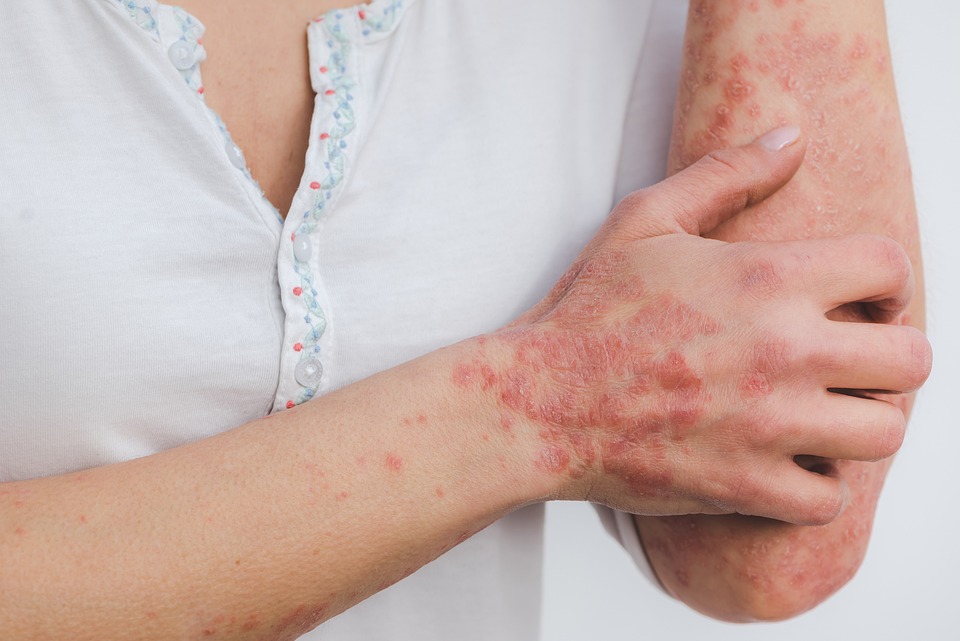When discussing the signs of psoriasis, a majority of people mention the red, rough, and scaly lesions that are related to plaque psoriasis, the most frequent type of the affliction. However, there are various varieties of psoriasis, each one exhibiting distinct indications and characteristics. Furthermore, some varieties of autoimmune sickness can be easily interpreted as other ailments and it can be difficult to reach the right diagnosis.
What Is Psoriasis?
Psoriasis is an ongoing immune system disorder leading to a fast accumulation of surface skin cells. The accumulation of cells leads to the formation of scales on your skin’s exterior. Inflammation and redness around the scales are fairly common. The ordinary kind of psoriatic scabs tend to be light grayish-silver in colour and emerge in large, reddened areas.
For those with darker skin tones, the appearance could be described as purplish, dark brown tinged with gray. Sometimes, the skin in the afflicted patches can rupture, causing it to weep blood. Psoriasis is caused by the excessively fast regeneration of skin cells. Usually, your skin’s cells start to form in the lower layers of the epidermis and gradually make their way to the outside. Eventually, they fall off.
The usual duration of a skin cell’s lifespan is 1 month. In people with psoriasis, the manufacture of new skin cells may take place over the span of only a few days. Due to this, skin cells are unable to detach. There is a speedy excess of cells being made which results in a buildup of skin cells.
Joints like elbows and knees typically have scales on them. However, they may develop anywhere on your body, including the:
- hands
- feet
- neck
- scalp
- face
Less common types of psoriasis affect the:
- nails
- mouth
- area around the genitals
One study from 2021 revealed that approximately 7.5 million adults in the United States ages 20 or older have psoriasis – a rate of occurrence of 3 percent. By race and ethnicity, the prevalence rates are:
- 3.6 percent of white people
- 3.1 percent of non-Hispanic people, including multiracial people
- 2.5 percent of Asian people
- 1.9 percent of Hispanic people, including Mexican American people
- 1.5 percent of Black people
It’s commonly associated with several other conditions, including:
- type 2 diabetes
- inflammatory bowel disease
- heart disease
- psoriatic arthritis
- anxiety
- depression
Frequent Symptoms
The signs and symptoms of psoriasis correlate to the kind of psoriasis one has. The outward signs of skin disorder are frequently seen, but their appearance can differ, and there may not be any symptoms in some instances. Certain variants of psoriasis are exclusive to the nails, joints, or areas of the body.
Psoriasis symptoms will develop in acute episodes called flares. Often, flares are induced by factors like stress, prescriptions, or even a skin injury. Occasionally, occurrences will arise without an identifiable cause and disappear just as abruptly. Even though psoriasis can be an ongoing issue, there may be times when the problem will suddenly worsen, or it may get better for a period.
Plaque Psoriasis
Roughly the majority of all instances of psoriasis are plaque psoriasis, which is known as the archetypal form of the condition. Plaque psoriasis is defined by:
- The appearance of superficial red patches of skin covered with white to silvery scales
- Itching
- Cracking
- Dryness
Patches may appear on any part of the body, but they are most routinely found on the inside of joints, like the bend of an elbow or the back of a knee. The eruption may appear on the head, countenance, and in or around the auditory areas. The rashes will sometimes join together and spread to cover larger parts of the body.
The outer layer of scales on skin may come off easily, but the underlying scales are more stubborn and can cause bleeding if scratched. This phenomenon results in a recognized symptom known as the Auspitz sign, which looks similar to scabies because of the presence of small, pinpointed bleeds.
When plaque psoriasis affects the head, it can easily be misidentified as dandruff (seborrheic dermatitis). For psoriasis, the skin that is affected will be dehydrated and display a shimmer of silver; whereas, seborrheic dermatitis commonly causes oily skin. Psoriasis affecting the scalp might range from minor, consisting of lower amounts of lesions on the back of the head and neck, to widespread, affecting the entire head.
Psoriasis may be located on the face, which could involve the eyebrows, upper lip, and the area around the face’s hairline. In very few cases, psoriasis can appear on the gums or inside the nostrils, the sides of the face, or the mouth. These sores can be either off-white or grayish in appearance and may make it hard to bite or swallow. Psoriatic lesions are similar to aphthous ulcers, but they generally do not have a single point in the middle.
Psoriasis can cause problems in the ear as the dead skin cells can pile up inside the ear passage. The signs that may be present could be soreness, irritation, an obstruction of earwax, and a decrease in capability of hearing.
Nail Psoriasis
It is estimated that over half of those affected with skin psoriasis also experience nail psoriasis, which is characterized by an excess of keratinocytes in the nail growth region. In contradiction, the National Psoriasis Foundation (NPF) has shown that 5% of people with nail psoriasis do not demonstrate any indications of skin psoriasis.
The signs and indications of nail psoriasis are alike to other nail maladies, including onychomycosis (nail fungus). They include:
- Pitting (small dents or pits on the surface of the nail plate)
- Distal onycholysis (lifting of the nail from the nail bed)
- “Oil drops” (a translucent, yellow-red discoloration in the nail bed)
- Subungual hyperkeratosis (thickening and scaling of the nail)
- Leukonychia (white patches on the nail plate)
The most severe form of nail psoriasis can make the nail become very rough, fractured, and unattractive. This could cause not just embarassement but also impede someone’s capability of moving about.
Guttate Psoriasis
Bumps resulting from a guttate psoriasis rash can be described as:
- Small
- Raised
- Pink
- Teardrop-shaped
The eruption can show up unexpectedly on the chest, arms, or legs, typically after a viral or microbial illness such as strep throat, chickenpox, or the normal cold. It is more widespread among kids since they are more vulnerable to these illnesses.
Inverse Psoriasis
This particular type of psoriasis, which is sometimes referred to as intertriginous psoriasis, is a rare occurrence that usually affects the areas between skin folds. Psoriasis that manifests on parts of the body such as behind the ears, underneath the chest, between the legs, on the armpits, or in the groin is called inverse psoriasis.
Since these areas are usually damp, the patches will not be dry and flaky. Rather, skin affected by inverse psoriasis appears:
- Smooth
- Red
- Glistening
Pustular Psoriasis
Pustular psoriasis is indicated by abscesses filled with pus instead of the typical scaly patches. The accumulation of deceased white blood cells and lymph fluid doesn’t spread the disease.
There are several subtypes of pustular psoriasis. The rash in the main variety of this disorder will only show up on limited portions of the body like the hands, soles, digits, or toes. Von Zumbusch psoriasis is a more extreme variety of the condition which can affect vast portions of the body.
Typically, it initiates with widespread redness and soreness, after which white sores spring up in bends of the skin (including the backs of the legs or within the arms, pits, or groin).
The other possible effects of having Von Zumbusch psoriasis are a fever, shivering, dehydration, accelerated heartbeat, weariness, weight loss, and lack of strength. If not handled promptly, the sickness can move into the bloodstream and can be deadly.
Erythrodermic Psoriasis
Erythrodermic psoriasis is an infrequent and serious manifestation of the disorder characterized by extensive skin loss from the entire body. Rather than peeling off in tiny pieces, the skin will separate and come off in large pieces. Erythrodermic psoriasis can resemble a serious burn or a type of Stevens-Johnson syndrome or toxic epidermal necrolysis created by medication.
Erythrodermic psoriasis can also cause:
- Severe itching and pain
- Tachycardia (abnormally rapid heart rate)
- Fluctuations in body temperature
- Dehydration
If not taken care of, erythrodermic psoriasis has potential to be lethal, possibly resulting in grave infections (for example, sepsis or pneumonia) or heart failure.
Is Psoriasis Contagious?
Psoriasis is not contagious. It is not possible for one person to transmit the skin condition to another. You cannot get psoriasis from touching someone else who has it. It is essential to have knowledge regarding psoriasis, as many individuals mistakenly believe it to be an infectious disease.
What Causes Psoriasis?
Doctors are unclear as to what causes psoriasis. However, thanks to decades of research, they have a general idea of two key factors:
- genetics
- the immune system
Immune System
Psoriasis is an autoimmune condition. Your body is causing harm to itself due to autoimmune conditions. In psoriasis, the occurrence of T cells (white blood cells) attacking your skin cells is an error. Typically, white blood cells are sent out in the body to fight off invading microorganisms and create a shield against disease.
In this incorrect immune system response, the creation of skin cells accelerates. The accelerated rate of skin cell growth leads to the creation of new skin cells at a faster than normal pace. The pressure causes them to rise to the top of the skin, where they form a layer. This leads to the formation of the patches that are most recognizable with psoriasis. The assaults on the dermal cells lead to the formation of red, swollen regions on the skin.
Genetics
Some individuals are born with genetic markers that can increase the probability of getting psoriasis. Studies from 2019 show that if you have a close relative with psoriasis, you are more likely to get it yourself.
Diagnosing Psoriasis
It might be necessary to carry out two assessments or exams to identify psoriasis.
Physical examination
Most medical professionals can determine a diagnosis with a routine physical exam. It’s important to be sure to let your physician see all sections where you are experiencing symptoms that may be related to psoriasis, as it may be easier to spot than other health issues producing congruent indications. Additionally, make sure to inform your physician if any of your relatives have the same condition.
Biopsy
If your symptoms are unclear or if your physician is trying to verify their diagnosis, they may take a small piece of your skin. This is known as a biopsy. At your doctor’s appointment, a biopsy can be performed on the same day. Your physician will most likely administer a local anesthetic to lessen the discomfort of the biopsy.
A lab will then be given the skin biopsy for examination, which will undergo observation with a microscope. The test can determine what kind of psoriasis you have. It is also possible to eliminate other potential health issues or infections. Once the results are back, your physician may make arrangements to have a meeting to go over the data and discuss potential treatments with you.
Psoriasis Triggers: Stress, Alcohol, And More
External “triggers” may start a new bout of psoriasis. These triggers are not the same for everyone. They may also change over time for you.
The most common triggers for psoriasis include:
Stress
Unusually high stress may trigger a flare-up. If you can figure out how to lower and keep track of your tension, you may be able to diminish and perhaps stop outbursts.
Alcohol
Alcohol use disorder can trigger psoriasis flare-ups. Drinking too much can cause psoriasis flare-ups to become more common. Thinking about lowering your drinking or completely stopping is beneficial for more than just your skin. Your physician can provide you with help in designing a strategy to face your worries about your alcohol consumption if you require it.
Injury
An accident, cut, or scrape may trigger a flare-up. Injections, vaccinations, and sun exposure can all result in a new outbreak of skin diseases.
Medications
Some medications are considered psoriasis triggers. These medications include:
- lithium
- antimalarial medications
- high blood pressure medication
Infection
The immune system erroneously strikes healthy skin cells, which contributes to the development of psoriasis. If you have contracted an illness, for example an infection, your immune system can, unfortunately, respond incorrectly and begin to attack your own body in addition to fighting the infection.
This might start another psoriasis flare-up. Strep throat is a common trigger.
Treatment Options For Psoriasis
Psoriasis has no cure. Treatments aim to:
- reduce inflammation and scales
- slow the growth of skin cells
- remove plaques
Psoriasis treatments fall into three categories:
Topical Treatments
Topical applications of creams and lotions can be beneficial in alleviating mild to moderate psoriasis.
Topical psoriasis treatments include:
- topical corticosteroids
- topical retinoids
- anthralin
- vitamin D analogues
- salicylic acid
- moisturizer
Systemic Medications
Individuals with psoriasis that ranges from mild to intense in nature, as well as people who have not had much success with other treatment choices, may need to take oral or injected drugs.
A lot of these drugs may cause intense adverse effects and therefore, physicians usually recommend them for brief stretches of time.
These medications include:
- methotrexate
- cyclosporine (Sandimmune)
- biologics
- oral retinoids
Light Therapy
This psoriasis treatment uses ultraviolet (UV) or natural light. The sun’s rays can destroy the abnormal white blood cells that are attacking normal skin cells and causing them to multiply quickly. It is possible that both UVA and UVB rays might be beneficial in relieving the signs of mild to moderate psoriasis.
The majority of those afflicted with a serious to life-threatening psoriasis condition should experience positive outcomes from employing a mix of remedies. This form of therapy employs multiple techniques to lessen symptoms. Certain individuals may keep to the same therapeutic regimen throughout their lives. Some people may have to switch to a different course of treatment if their skin no longer responds to their current treatment.
When to See a Healthcare Provider
It is recommended to get in touch with a medical professional if you believe you have psoriasis instead of attempting to work out what it is on your own. At times, an issue that looks like psoriasis may turn out to be something completely different like lupus or squamous cell skin cancer. The best type of specialist to determine a diagnosis concerning skin health and disease is undoubtedly a dermatologist who has been educated in such areas.









